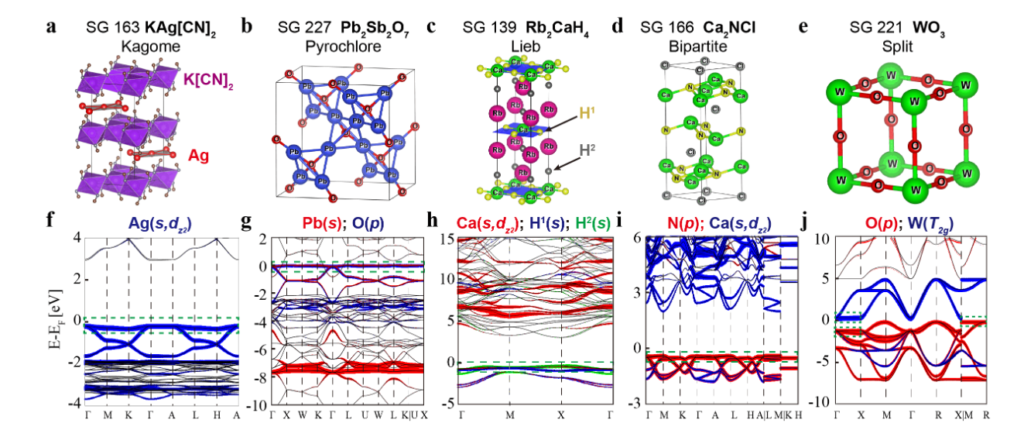A powerful search engine for flatband stoichiometric materials
Imagine a conductor or a semiconductor through which a current is flowing. Then we apply a strong transverse magnetic field. As a result, we can measure a potential difference at right angles to both the current and the field caused by the deflection of charge carriers by the field. This effect was described by Edwin Hall in 1879 and is the classical Hall effect. It introduces a coefficient, RH, a constant characteristic of the material.
A quantum mechanical version of the Hall effect can be found at very low temperatures, in which the Hall coefficient RH is quantized. And, depending on the values of the coefficient, there are two types of quantum Hall effect. The integer quantum Hall effect has RH given as an integer with great precision. It can be used for precision measurements of constants such as e (the elementary charge) and h (Planck’s constant). In the fractional quantum Hall effect, RH has fractional values. The integer quantum Hall effect can be understood in terms of non-interacting electrons, whereas the fractional effect is thought to result from many-electron interactions in two-dimensional systems. Such electrons form a high density of states “flat band”, where many-body effects dominate over the kinetic energy and where Fermi-surface physics gives way to strongly interacting, non-Fermi liquid behaviour.
New developments in engineered solid-state materials have now shown that flat bands can exist even in the absence of a large magnetic field. In moiré materials such as (but not limited to) twisted bilayer graphene, flat electronic bands are obtained by creating a large, many nanometer-size moiré unit cell which folds and flattens the initial band structure of the material. However, as the unit cell is large, the electron density in moiré samples is necessarily low, preventing any new type of physics associated with high electron density.
The point is that topological electronic flatten bands near or at the Fermi level may be the path towards unconventional superconductivity and correlated insulating states, but it has been investigated experimentally mostly in engineered materials, such as moiré systems. What about the myriad of three-dimensional systems out there?

Now, a team of researchers addresses for the question of predicting and classifying all the flat bands in all the stoichiometric crystals currently present in nature. The result 1 is a powerful search engine for future experimental and theoretical studies.
To build this search engine, the researchers considered 55,206 materials from the Inorganic Crystal Structure Database (ICSD) catalogued using the Topological Quantum Chemistry website which provides their structural parameters, space group, band structure, density of states and topological characterization.
The team developed algorithms for the detection and classification of flat bands near the Fermi level. Several signatures and properties of band flatness were identified: bandwidth, peaks in the density of states, band topology, range of momenta over which the band is flat and the energy window around the Fermi level where the flat bands are situated. A high-throughput analysis of all crystal structures identified those hosting line-graph or bipartite sublattices – either in two or three dimensions – that likely lead to flat bands.
With all this information, the researchers created the Materials Flatband Database. The scientists used it to perform a manual check of thousands of materials for the best flat bands. They selected 2,379 materials with high-quality flat bands near the Fermi level. Among them, 345 promising candidates, potentially hosting flat bands whose charge centers are not strongly localized on the atomic sites. Finally, for some representative materials a theoretical explanation of the origin of flat bands is provided using a model previously developed by the team.
These results are an important step in the understanding, both from the theoretical and the experimental points of view, of flat-band materials combining topology and interactions and leading to exotic quantum phenomena, such as magnetism, non-Fermi liquid behaviour and superconductivity.
Author: César Tomé López is a science writer and the editor of Mapping Ignorance
Disclaimer: Parts of this article may have been copied verbatim or almost verbatim from the referenced research paper/s.
References
- Nicolas Regnault, Yuanfeng Xu, Ming-Rui Li, Da-Shuai Ma, Milena Jovanovic, Ali Yazdani, Stuart S. P. Parkin, Claudia Felser, Leslie M. Schoop, N. Phuan Ong, Robert J. Cava, Luis Elcoro, Zhi-Da Song & B. Andrei Bernevig (2022) Catalogue of flat-band stoichiometric materials Nature doi: 10.1038/s41586-022-04519-1 ↩
1 comment
[…] A powerful search engine for flatband stoichiometric materialsQuímica Cuántica Topológica MagnéticaUn catálogo de estructuras magnéticas topológicasLa teoría de bandas de los sólidos se hace topológica […]